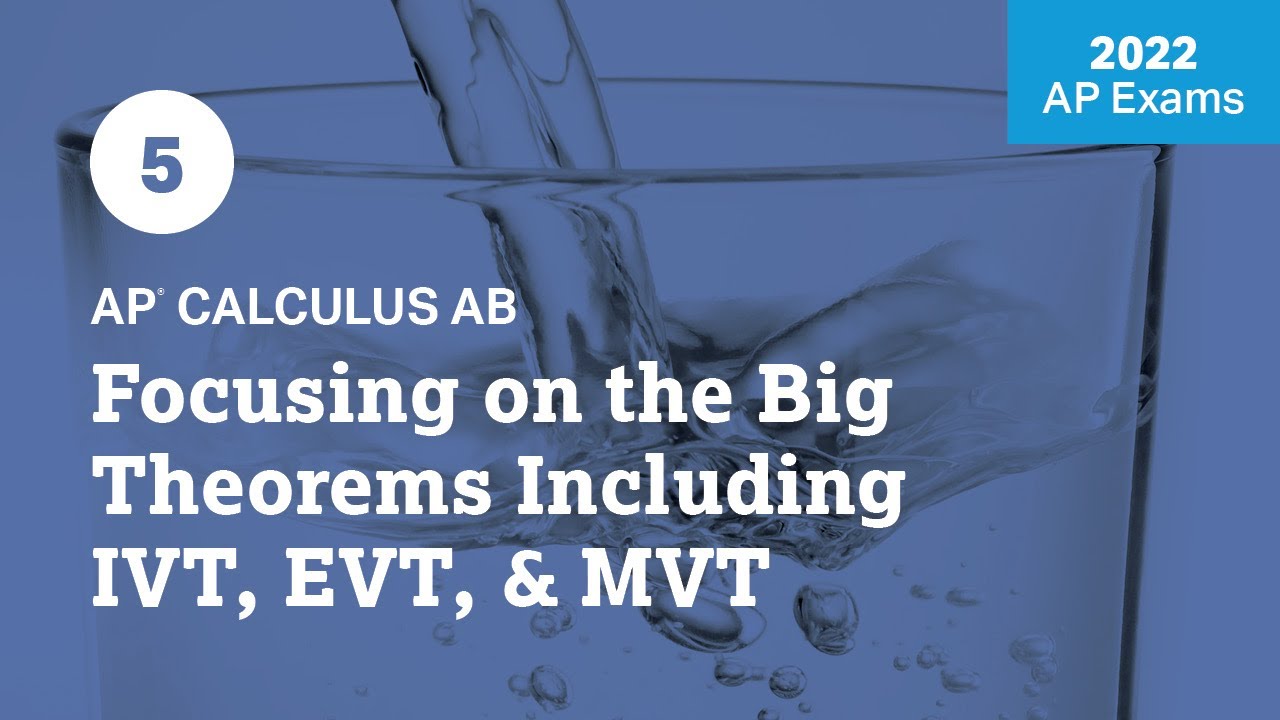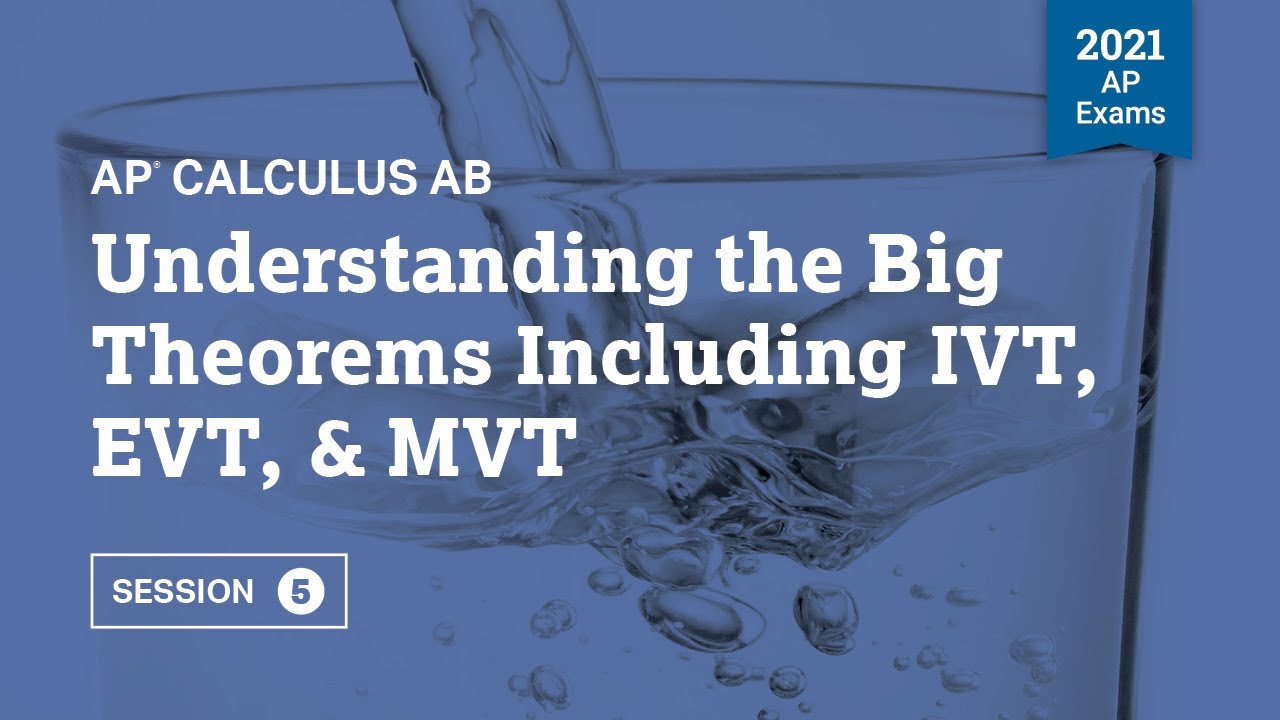Fall 2023 MNC: Trick or treat - Some important theorems in differential calculus
TLDRIn this engaging Monday Night Calculus session, Curtis Brown is joined by Tom and Steve to delve into important calculus theorems, including continuity and differentiability. They explore how to find values of constants for a piecewise function to ensure continuity and apply the intermediate value theorem to demonstrate the existence of roots within specified intervals. The use of technology, specifically the TI-84 calculator, is highlighted to illustrate and solve problems, emphasizing the practical application of these theorems in solving real-world problems.
Takeaways
- 📘 The session was a calculus discussion led by Curtis Brown, joined by Tom, Dick, and Steve, focusing on important theorems in calculus.
- 🎥 The group was live streaming from Washington DC, discussing theorems that are often abbreviated with letters and are key when grading the AP Calculus exam.
- 📝 Curtis admitted to not completing his homework, relying on chat for assistance and highlighting the importance of continuity in functions.
- 📊 The discussion involved analyzing a piecewise function's continuity, focusing on transition points where constants A and B need to be determined for the function to be continuous everywhere.
- 🔢 A method for finding values of A and B for the continuous function was explored, involving taking limits and setting up equations based on left-hand and right-hand limits at transition points.
- 📈 Tom demonstrated how to use a TI-84 calculator to graph the piecewise function and find suitable values for A and B to ensure continuity.
- 🔍 The Intermediate Value Theorem (IVT) was discussed, emphasizing the need for a single continuous function over a closed interval to apply the theorem.
- 🌟 The session touched on the Mean Value Theorem (MVT) and its special cases, including when the endpoints evaluate to zero, known as Rolle's Theorem.
- 🛠️ The use of technology, such as the TI-84 and TI-Inspire calculators, was highlighted for solving calculus problems, including finding roots and derivatives.
- 📚 The importance of correctly citing theorems in AP Calculus exams was stressed, with clarifications on acceptable shorthand like IVT, MVT, and EVT.
- 🎓 The session concluded with a reminder for teachers to email Curtis for a certificate of completion and an announcement of upcoming Monday Night Calculus and Pre-Calculus sessions.
Q & A
What is the main topic of discussion in the video?
-The main topic of discussion in the video is the exploration of important theorems in calculus, specifically focusing on functions, continuity, and the application of the intermediate value theorem and mean value theorem.
What is the significance of the function f(x) in the video?
-The function f(x) is a piecewise-defined function used to illustrate the concepts of continuity and the process of determining the values of constants A and B to ensure the function is continuous everywhere.
How does Curtis Brown approach the problem of finding the values of A and B for the function f(x)?
-Curtis Brown approaches the problem by analyzing the continuity of the function at the transition points (x=2 and x=3), setting up equations based on the left-hand limit and the function's value at these points, and solving the system of equations to find the values of A and B.
What is the intermediate value theorem mentioned in the video?
-The intermediate value theorem is a fundamental theorem in calculus that states if a function is continuous on a closed interval [a, b], and k is any number between f(a) and f(b), then there exists at least one number c in the interval [a, b] such that f(c) = k.
How does the video demonstrate the application of the intermediate value theorem?
-The video demonstrates the application of the intermediate value theorem by showing how to use it to prove the existence of a root for a given equation within a specified interval. It also uses technology to graph functions and find the approximate values of the roots.
What is the mean value theorem discussed in the video?
-The mean value theorem is a key concept in calculus that states if a function is continuous on a closed interval [a, b] and differentiable on the open interval (a, b), then there exists at least one number c in the interval (a, b) such that the derivative of the function at c is equal to the average rate of change of the function over the interval [a, b].
How does the video use technology to enhance the understanding of calculus concepts?
-The video uses technology, specifically the TI-84 calculator, to graph functions, find the approximate values of roots, and illustrate the concepts of continuity and differentiability. This visual representation helps to clarify the abstract concepts discussed in the video.
What is the significance of the particle motion problem discussed in the video?
-The particle motion problem is used to demonstrate the application of calculus concepts, such as average velocity, instantaneous velocity, and acceleration, in a real-world context. It shows how these concepts can be used to analyze and understand the behavior of a moving object.
How does the video address the issue of students misspelling 'intermediate value theorem' as 'mean value theorem'?
-The video emphasizes that while 'intermediate value theorem' is a well-known term and is generally understood by those familiar with calculus, students should be careful to use the correct terminology to avoid confusion, especially in the context of an exam like the AP Calculus exam.
What is the special case of the mean value theorem mentioned in the video called?
-The special case of the mean value theorem mentioned in the video, where the function evaluates to zero at the endpoints, is called Rolle's Theorem.
What advice is given to teachers who have watched the video in its entirety?
-Teachers who have watched the video in its entirety are encouraged to email Curtis Brown to receive a link to download a certificate for the session, which they can use for professional development or to show completion of the course.
Outlines
🎓 Introduction to Monday Night Calculus
The video begins with Curtis Brown welcoming viewers to Monday Night Calculus, a live streaming session from Washington DC. He is joined by Tom and Steve, and they express excitement for the upcoming discussion. Curtis humorously admits he hasn't done his homework and may rely on the chat for assistance. The session aims to cover important theorems in calculus, with a focus on those relevant to the AP Calculus exam.
📚 Analyzing a Piecewise Continuous Function
The main topic of discussion is a piecewise defined function, and the challenge is to find values for constants A and B that ensure the function is continuous everywhere. The analysis involves examining the function's continuity at specific points and setting up equations based on the left-hand limit and the function's value at those points. The problem-solving process is interactive, with contributions from the participants and the chat audience.
📱 Using Technology for Graphical Representation
Tom demonstrates how to use a calculator (specifically the TI-84) to graph the piecewise function discussed earlier. He explains how to input the function and its domain into the calculator and how to adjust the viewing window for a better visual representation. The use of technology is emphasized as a tool for understanding and verifying the continuity of the function.
🤔 Exploring Continuity and Differentiability
Steve and Tom engage in a deeper discussion about the properties of continuous and differentiable functions. They touch on the implications of these properties for theorems in calculus and how they can be applied to problem-solving. The conversation also includes a reflection on the importance of correctly applying the intermediate value theorem and the mean value theorem in calculus.
📈 Applying the Intermediate Value Theorem
Curtis, Tom, and Steve explore the intermediate value theorem (IVT) through various problems. They discuss how to apply IVT to determine the existence of roots for given equations within specific intervals. The discussion includes the use of both analytical methods and technology to find these roots, emphasizing the practical application of the theorem in solving calculus problems.
🌟 Bonus Question and Final Thoughts
The session concludes with a look at a bonus question involving a particle's motion and the application of several important calculus theorems. The hosts also discuss the use of shorthand for theorems in AP Calculus exams and the importance of correctly citing theorems. They wrap up with a reminder about future Monday Night Calculus sessions and encourage teachers to engage with the content.
Mindmap
Keywords
💡Calculus
💡Theorems
💡Continuous Function
💡Piecewise Function
💡Derivative
💡Graphing
💡AP Calculus Exam
💡Mean Value Theorem
💡Intermediate Value Theorem
💡Trigonometry
💡Technology
Highlights
Introduction of Monday Night Calculus and the hosts Curtis Brown, Tom, Dick, and Steve.
Discussion on the importance of theorems in calculus and their application in the AP Calculus exam.
Analysis of a piecewise-defined function to ensure its continuity across different intervals.
Explanation of how to use the chat feature and its role in interactive learning during the live stream.
Demonstration of the continuity of rational functions and their domain.
Use of polynomial functions to establish continuity between intervals and the role of constants A and B.
Discussion on the concept of limits and their application in determining the continuity of functions at specific points.
Mention of the Intermediate Value Theorem and its significance in calculus.
Illustration of the application of the Intermediate Value Theorem to find the roots of given equations within specified intervals.
Use of technology, specifically the TI-84 calculator, to graph and analyze functions and their continuity.
Explanation of the Mean Value Theorem and its application in finding average velocity and instantaneous velocity of a particle in motion.
Discussion on the Extreme Value Theorem and its implications for finding maximum and minimum values of continuous functions on closed intervals.
Introduction of the Transform App on the TI-84 calculator for exploring the impact of changing parameters on function graphs.
Demonstration of the Candidates Test for identifying extreme values of a function on a closed interval.
Closing remarks and information on how teachers can obtain a certificate for professional development hours by watching the session.
Transcripts
Browse More Related Video

Monday Night Calculus: Rectilinear motion

Fall 2023 MNC: Slice thin and add - Riemann sums and definite integrals

2022 Live Review 5 | AP Calculus AB | Focusing on the Big Theorems Including IVT, EVT, & MVT

Monday Night Calculus: Substitution

2021 Live Review 5 | AP Calculus AB | Understanding the Big Theorems Including IVT, EVT, & MVT

Fall 2023 MNC: Up close and personal with differentiability and local linearity
5.0 / 5 (0 votes)
Thanks for rating: